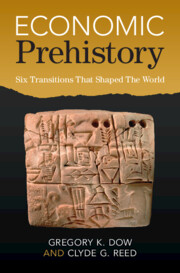Book contents
- Economic Prehistory
- Economic Prehistory
- Copyright page
- Dedication
- Contents
- Figures
- Tables
- Preface
- Acknowledgments
- Abbreviations
- Part I Prologue
- Part II Sedentism and Agriculture
- Part III Inequality and Warfare
- Part IV Cities and States
- Part V Epilogue
- 12 Bridges to the Present
- References
- Author Index (Abridged)
- Subject Index
12 - Bridges to the Present
from Part V - Epilogue
Published online by Cambridge University Press: 10 February 2023
- Economic Prehistory
- Economic Prehistory
- Copyright page
- Dedication
- Contents
- Figures
- Tables
- Preface
- Acknowledgments
- Abbreviations
- Part I Prologue
- Part II Sedentism and Agriculture
- Part III Inequality and Warfare
- Part IV Cities and States
- Part V Epilogue
- 12 Bridges to the Present
- References
- Author Index (Abridged)
- Subject Index
Summary
We close with some linkages between prehistory and the modern world. We survey an empirical literature in economics arguing that regions where agriculture began early, or state formation occurred early, have higher per capita incomes or more rapid economic growth in the present. Another literature in economics involves the use of growth theory to explain the full trajectory from Neolithic agriculture to the Industrial Revolution, the recent demographic transition to slower population growth, and rising per capita incomes in advanced economies. We also discuss hypotheses about the transition from elite-dominated states in prehistory to widespread democracy today. Against this backdrop we consider the evolution of human welfare, as measured by nutrition, health, and life expectancy, from mobile foraging bands to modern societies. Theory and evidence suggest that welfare diminished in the transitions to sedentism and agriculture, and then remained low for commoners due to stratification and Malthusian population dynamics. But during the last 100–150 years the Industrial Revolution, the Demographic Transition, and political democratization have made billions of people better off. We conclude by discussing the role of climate change in prehistory, along with some lessons about the likely effects of global warming in the future.
Keywords
- Type
- Chapter
- Information
- Economic PrehistorySix Transitions That Shaped The World, pp. 485 - 529Publisher: Cambridge University PressPrint publication year: 2023

